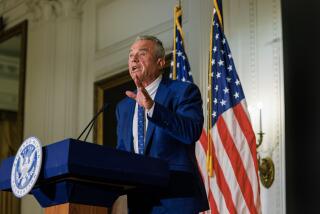Addictology Shows Doctors Their Diseases Can Be Treated
- Share via
OAKLAND — Physicians hooked on their own medicines, strung out on illegal narcotics or killing themselves with alcohol are finding help through a new discipline--addictology--and a growing network of support systems for health care professionals.
With the American Medical Assn. this year classifying all addictions as diseases, usually genetically triggered, some of the stigma attached to drug and alcohol dependency is diminishing.
Doctors and nurses, in particular, understand the word treatable, and thousands of them nationwide are entering recovery programs to shed addictions that have shattered or threaten to destroy their personal and professional lives.
One doctor asked for chemical-dependency treatment after his family life fell apart, his finances collapsed and his practice started deteriorating. Other addicted doctors report such frightening scenarios as falling asleep in the operating room. One surgeon was sent to a recovery program by intervening colleagues after he tried to remove an organ by hand while experiencing toxic psychosis from cocaine.
10% Have Dependencies
The AMA estimates that 10% of the nation’s half a million doctors suffer from alcoholism or drug dependency, with 100 practicing physicians dying annually from their disease.
Experts say statistics show that those at most risk of becoming drug or alcohol dependent are critical-care nurses and among doctors, anesthesiologists who work full time in the operating room.
A tough program to help physicians and nurses recover from addictions has been put together at the Merritt Peralta Institute near Merritt Hospital in Oakland. Those accepted must already have gone through an inpatient or outpatient program for chemical dependency and be willing to sign a “tailored contract” agreeing to follow an intensive one-year monitored regimen.
“People need to devote as much time to recovery as they did to the disease,” said program coordinator Millicent Buxton, who makes clients agree to change their “survival tools” from drugs to active participation in a 12-step program such as Alcoholics Anonymous or Narcotics Anonymous, join a professional support group, meet weekly with a program staffer and agree to random urine testing.
Abstinence from all drugs, including alcohol, is mandatory, she said. Participants must also agree to a work-site monitor who will report any unusual behavior that might indicate a relapse.
“We believe in a chemical-free philosophy as the appropriate treatment,” said Buxton, adding that researchers are now finding genetic similarities linking all addictions, from alcoholism to obsessive gambling.
Addiction to prescription drugs is the biggest danger to doctors and nurses because the “cookie jar is always available,” Buxton said.
Especially in high-stress situations, she said, self-medication is sometimes a coping mechanism. The key words, she added, are “high stress, high access.”
“For health professionals, the role as healer may increase their denial when the disease develops in themselves. Because of their knowledge of pharmacology, many think they are immune to the addiction.”
Medical Schools Ignore Subject
Dr. Lyman Boynton, a surgeon and recovering alcoholic at Kaiser Hospital in San Francisco, recently taught a weekend primer course on drugs and alcohol abuse for doctors who want to specialize in that area. The doctors were among 800 who then took a national addictology exam that certifies them as having expertise in the emerging field. Only three other such national exams have so far been administered, with 645 doctors receiving certification from the AMA’s committee on alcoholism and other drug dependencies.
“Obviously, a major goal is education, teaching an awareness of addictions and cross-tolerances,” Boynton said. “The disease is chemical dependency, it’s not cokism or valiumism or alcoholism.”
Boynton, who heads a support group of doctors recovering from addictions, said a large number of those who enter the practice of addictology have suffered the effects of the disease. Unfortunately, he adds, medical schools virtually ignore the subject, except in elective courses, despite the fact that alcoholism alone is the nation’s third-leading cause of death.
Doctors in recovery, he said, benefit from such programs as Merritt Peralta’s monitoring and re-entry, because the addiction is treated as curable and doctors are permitted to resume practice, without putting patients or the hospital in jeopardy, by signing the sobering “contract” agreement. Being able to work, rather than being disciplined by a license suspension, also helps in the physician’s recovery, Boynton said.
“Chemical dependency is an eminently treatable disease and that’s the real key,” Boynton said. “People can be returned to their workplace and be a real asset to their profession.”
Boynton said of all the chemical dependencies, alcohol is the deadliest because it is water-soluble and poisons every cell in the body. Detoxification from heavy alcohol use, he said, is often life-threatening and more dangerous than cleansing the body of cocaine or heroin abuse.
Buxton said researchers at Merritt Peralta have developed a formula that describes the predisposition toward addiction: G plus E equals CD, or Genetics plus Environment equals Chemical Dependency. In 70% of all patients, Buxton said, there is a reported family history of drug abuse or alcoholism.
“We live in a society that condones the use of psychoactive drugs, including alcohol,” Buxton said. “Unfortunately, once a person with genetic predisposition gets involved and the process has started, there’s no stopping the addiction.”
Tried 30 to 35 Drugs
One emergency room doctor, who asked to remain anonymous, said she considered a life style of moderate alcohol and recreational drug use “totally reasonable” until she started stealing prescription medicine, mostly the pain-killer Demerol, and eventually tried 30 to 35 other drugs used at the hospital.
“I realized very quickly that I would eventually get caught, that someone would notice, and that scared me,” she said. “I never saw my dependency and thought I had a special gift that enabled me to do drugs.”
After getting help from a therapist to stop using prescription drugs, she started drinking heavily until the habit turned into full-blown alcoholism.
“I used to look at the empty bottles of vodka in my garbage and couldn’t believe it,” she said, adding that her therapist could not see that she needed structured help, including hospitalization. It was not until she went to a psychologist who specialized in addictive behavior that she finally got proper treatment.
After five weeks in the hospital and two months in an intensive recovery program, she joined the monitoring and re-entry program, signing a contract and agreeing to stay sober. She has since been back in the emergency room for 13 months without a relapse.
“I didn’t mind signing the contract,” she said. “I was really glad to have it available to me because I was very frightened when I got out of the hospital.”
Like most other doctors, she said, she learned little or nothing about substance abuse in medical school.
“To be honest, I was extremely naive,” she said. “I felt that drugs were a perk, I really believed that. I had no idea they would get me into trouble.”
In California, 222 doctors currently are undergoing monitoring in a physicians’ diversion program administered by the state Board of Medical Quality Assurance, which licenses and suspends doctors. Medical societies in about half of the other states sponsor recovery programs for doctors, but without having the leverage of disciplinary actions.
“Having their licenses at risk is a strong motivational factor,” said Chet Pelton, director of the program funded by the Legislature from a portion of physician license fees.
Since it began seven years ago, Pelton said, the program has had a 73% success rate, with 160 doctors “graduating” and the rest either losing their licenses or dying from complications of their disease.
“To leave the program, a doctor must demonstrate a minimum two years of sobriety plus a positive change of life style,” Pelton said.
About one-third of the doctors enter or are referred to the program because of alcohol problems. Among other addictions, Pelton said, prescription drug use is the most prevalent.
“We feel chemical dependency is a disease and just disciplining doctors will not help them with the disease,” he said.
More to Read
Sign up for Essential California
The most important California stories and recommendations in your inbox every morning.
You may occasionally receive promotional content from the Los Angeles Times.










